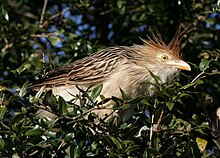Crotophaginae
| Crotophagines Temporal range: - Holocene,1.8–0 Ma |
|
|---|---|
 |
|
| Guira cuckoo, Guira guira | |
| Scientific classification | |
| Kingdom: | Animalia |
| Phylum: | Chordata |
| Class: | Aves |
| Order: | Cuculiformes |
| Family: | Cuculidae |
| Subfamily: |
Crotophaginae Swainson, 1837 |
| Type species | |
|
Crotophaga ani Linnaeus, 1758 |
|
| Genera | |
The Crotophaginae are a small subfamily, within the cuckoo family Cuculidae, of four gregarious bird species occurring in the Americas. They were previously classified as a family Crotophagidae.
The subfamily is notable for the development of cooperative breeding where several females lay eggs in a communal nest. It contains the three anis and the guira cuckoo.
Among the anis, there is considerable variation in nesting habits. One species, The greater ani C. major lays 2 or 3 eggs, while the groove-billed ani C. sulcirostris lays seven. However the smooth-billed ani C. ani will share one nest between several females, with up to 29 eggs in one nest. Incubation takes 15 days for this species.
Four species make up the subfamily, namely the guira cuckoo (Guira guira) and the three members of the genus Crotophaga known as anis. Study of the cranial osteology and yield the same phylogeny, namely that the Smooth-billed and groove-billed ani are each other's closest relatives, with the greater ani related and the guira cuckoo an earlier offshoot of the group.
The members of the family range from Florida in the north, through Central America and the West Indies and through South America south to Rio Negro in Argentina, in open habitats.
...
Wikipedia
